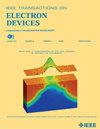氧空位动力学的一般物理模型,用于哈夫纳基薄膜的铁电性增强和衰减
IF 2.9
2区 工程技术
Q2 ENGINEERING, ELECTRICAL & ELECTRONIC
引用次数: 0
摘要
氧空位(V $_{\text {O}}\text {)}$ 缺陷已被证明会显著影响极化转换,尤其是在基于哈夫尼亚的铁电(FE)薄膜中。在这项研究中,我们建立了一个物理模型,以从根本上深入了解各种 VO 动态及其对 Hf $_{{1}-{x}}$ ZrxO2 (HZO) 薄膜中铁电响应的影响。具体来说,VO 在电场循环过程中的动态生成、漂移和扩散会改变 P-E 环路。因此,唤醒过程中铁电性增强以及随后疲劳过程中铁电性衰减的内在机制可以得到澄清。在唤醒过程中,VO 生成带来的 $2{P}_{\text {r}}$ 增强和 VO 迁移带来的夹缝打开同时发生。高浓度 VO 的聚集会停止对 $2{P}_{text {r}}$ 的贡献并降低 FE 特性。这些相互竞争的效应导致从铁电稳定阶段过渡到疲劳阶段。本文章由计算机程序翻译,如有差异,请以英文原文为准。
A General Physics Model of Oxygen Vacancy Dynamics for Ferroelectricity Enhancement and Degradation in Hafnia-Based Thin Films
Oxygen vacancy (V
$_{\text {O}}\text {)}$
defects have been proven to significantly influence polarization switching, particularly in hafnia-based ferroelectric (FE) thin films. In this study, we developed a physical model to delve into a fundamentally deeper understanding of various VO dynamics and their impacts on FE responses in Hf
$_{{1}-{x}}$
ZrxO2 (HZO) thin films. Specifically, the dynamic generation, drift, and diffusion of VOs during electric field cycles alter the P-E loop. Hence, the underlying mechanism of the ferroelectricity enhancement during wake-up and subsequent degradation during fatigue can be clarified. During the wake-up, the
$2{P}_{\text {r}}$
enhancement by VO generation and pinch opening by VO migration occur simultaneously. The aggregation of high-concentration VOs stops contributing to
$2{P}_{\text {r}}$
and degrades the FE properties. The competing effects lead to the transition from a ferroelectrically stable stage to fatigue.
求助全文
通过发布文献求助,成功后即可免费获取论文全文。
去求助
来源期刊

IEEE Transactions on Electron Devices
工程技术-工程:电子与电气
CiteScore
5.80
自引率
16.10%
发文量
937
审稿时长
3.8 months
期刊介绍:
IEEE Transactions on Electron Devices publishes original and significant contributions relating to the theory, modeling, design, performance and reliability of electron and ion integrated circuit devices and interconnects, involving insulators, metals, organic materials, micro-plasmas, semiconductors, quantum-effect structures, vacuum devices, and emerging materials with applications in bioelectronics, biomedical electronics, computation, communications, displays, microelectromechanics, imaging, micro-actuators, nanoelectronics, optoelectronics, photovoltaics, power ICs and micro-sensors. Tutorial and review papers on these subjects are also published and occasional special issues appear to present a collection of papers which treat particular areas in more depth and breadth.
 求助内容:
求助内容: 应助结果提醒方式:
应助结果提醒方式:


